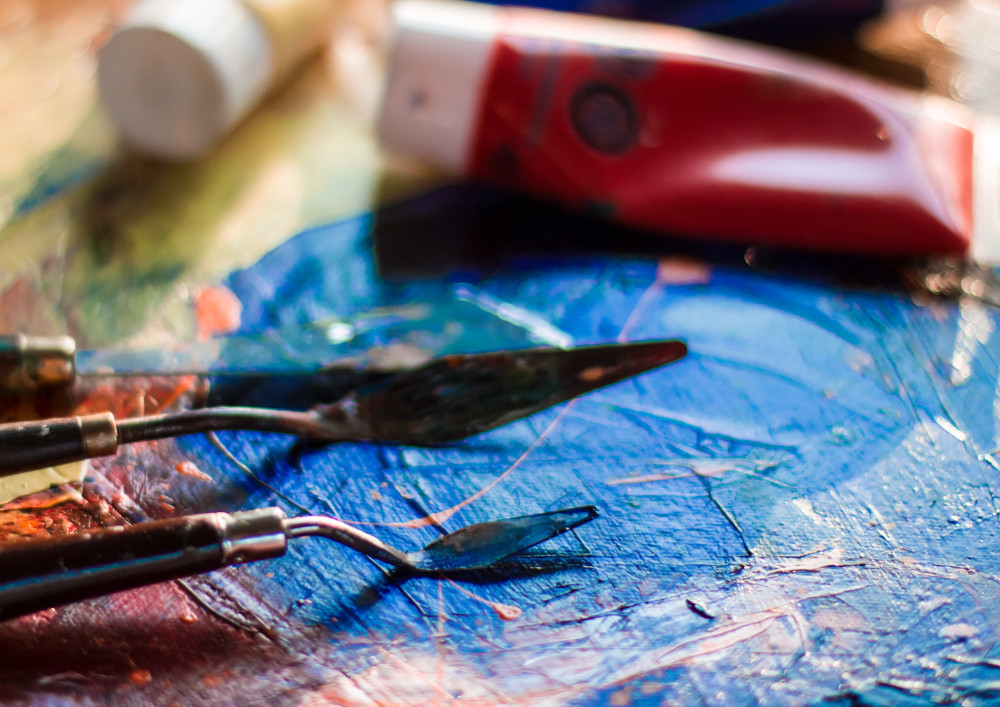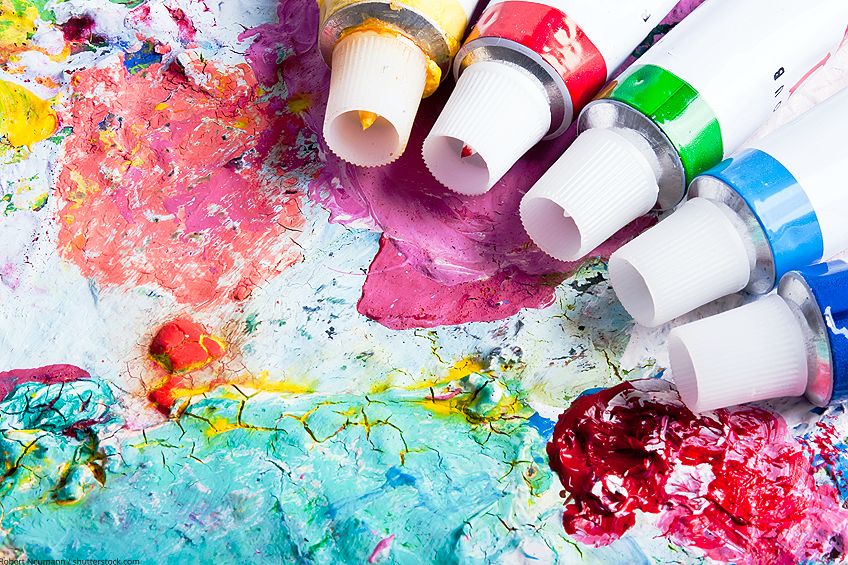Is acrylic paint waterproof
Acrylic paint is used by almost all artists in every industry imaginable. This is because they perform super well on almost every surface.
At the same time, they are cheap and easily available. Applying acrylic paint is also very easy, and they are often multipurpose paint mediums. But every multipurpose paint medium has to be resistant to environmental factors.
This is because if multipurpose colouring mediums respond negatively to harsh environmental conditions, they will reduce the durability of many products. This begs the question – is acrylic paint waterproof?

What are the advantages of waterproof paint?
Why are we looking for waterproof paint in the first place? Waterproof paint has several advantages, some quite self-explanatory, while others not so much.
Waterproof paint can be used out of doors.
Only a waterproof surface of the paint will last in outdoor conditions. Even if your area receives very little rain, there is still enough humidity and moisture out of doors to affect the condition of your painted surface.
A waterproof acrylic paint, which is quite easy to do, can make your homemade projects last for an everlasting time in your garden or backyard.
Waterproof paint makes surfaces easier to clean.
You will probably not be able to clean a surface that is painted with acrylic paint and is not waterproof. This will limit how you use it and whether your customers actually buy your product. A waterproof paint surface makes cleaning any object easier with soap and water.
Therefore, for objects of daily use, a waterproof painted surface is necessary. Although, it should be remembered that a waterproof acrylic paint surface should never be used as a cooking or eating utensil.
Waterproof paint increases the longevity of goods.
Most of the time, a waterproof paint surface not only increases the beauty and versatility of an object but also protects the surface underneath from environmental damage. This is another reason why painting the surfaces you use outdoors is a very good idea.
In turn, this increases the life of any object and makes them more durable in situations of routine usage.
Waterproof paint can be used on diverse tools.
You can use one set of acrylic paint on several different surfaces. This means as soon as you learn how to waterproof your painted surface, you can use that same technique or same materials everywhere.
We stated that waterproof paint could be used on various tools. In this situation, it should be noted that different surfaces might require different sealing processes.
Is acrylic paint waterproof?
The short answer to that question is, no, acrylic paint is not waterproof.
Acrylic paint, by nature, has some degree of water resistance. This saves them from accidental exposure to water once in a while. But, even in such cases, acrylic paint typically will fade when water exposes it.
The nature of acrylic is synthetic. However, even when an acrylic paint hue has dried and cured, water often used as a painting base for latex-based acrylic paints will continue to affect it. Every time they come in contact that is.
If we compare them both, it will be fair to say that oil-based acrylic paint is more suitable for products frequently exposed to water than latex-based paint. Oil-based acrylic is usually considered a better option for items intended to undergo rough use.
But it is important to note that even oil-based acrylic paints will not last that long when frequently exposed to moisture.
just like acrylic paint if you want to know if spray paint is waterproof then read our post on it
What happens when acrylic paint is frequently exposed to hydration?
Prolonged reactivity of acrylic painted surfaces with rain or other water sources eventually makes the paint surface chip, dust, or peel off after initial crack formations. This is because acrylic paint, as is its nature, absorbs water.
The good news for those who are phenomenally worried is that any average acrylic paint surface can be made waterproof using the correct sealant or varnish.

How to correctly paint waterproof acrylic paint?
This article segment is dedicated to assessing the various steps that can promise a perfect waterproof acrylic paint coating on any required surface. Here is how to correctly paint any surface with acrylic paint and have it stay for a long time.
Preparing the surface
Later in this article, we discussed how different surfaces respond to acrylic paint and how they can be waterproofed. The fact is acrylic paint sticks better on surfaces that are porous and rough in texture. This means very smooth and non-porous surfaces must be sanded before the painting begins.
Another important aspect of preparing a surface is thoroughly cleaning it. Especially, surfaces with uneven structures need to be cleaned and standard down properly for an evened-out result.
Priming
The more nonresponsive a surface is to acrylic paint, the more it is important to apply a good layer of primer beforehand. Surfaces like old wood or canvas shoes do not really require a primer unless you wish to add it.
Other surfaces like glass or plastic cannot do without a liberal amount of primer. The best way to apply primer is through thin layers and double coating. Remember to wait for the primer to drive before you start with the second coat.
Paint the surface
It is now time to paint the surface. Painting the surface is a relatively simple task, and its complexity depends totally on the designs chosen by the creator. Always remember the correct kind of paint and good tools can make the painting process easier and give the best results.
After the painting process, wait for your painted object to cure properly. Curing can take anywhere from around 24 hours to 3 days. Curing is an essential part of the painting process, which cannot be skipped or hurried through.
Apply the sealant
When it comes to waterproofing, nothing is more important than this step. Apply a slow and double coat of sealant. Choose a correct sealant, especially for the surface and conditions you are working with.
Allow the sealant to cure as well. Choosing the right sealant can make a huge difference regarding your waterproof acrylic painted surface. Objects like glass and ceramic respond well to being baked on the surface before sealing. This should be done very carefully.
What kind of varnish should be used to make acrylic paint waterproof?
There exists a difference between varnish and a sealant. In the fewest possible words, vanishing usually protects a painted surface from scratches and UV damage. It can be applied on many surfaces, though it is trickier than a sealant. Also, most varnish types get yellow over a long period.
For our purpose of moisture resistance, a sealant is a more favourable option. Usually, most of these are manufactured to keep moisture and dampness away from the paint’s surface and the metal or wood underneath. Sealers also prevent staining.
Sealant usually consists of resins or hardeners, making them non-porous to water. Often they also have an oil base which creates a further barrier between the paint and the external moisture. An oil-based sealant is more durable than a water-based one.
You will also find in the market something known as a spray varnish. Spray varnish is a varnish created for beginners and is a lot easier to use due to its uniform application. However, this effectiveness is not as an oil- or water-based varnish.
Some natural everyday products sometimes provide water resistance to an acrylic paint surface area.
- Sealant or Varnish
- Acetone base nail polish
- Waterproof glue
- PVA
Acrylic paint on wood
How can we ensure that the painted wood is waterproof?
Although what does not necessarily really require a heavy dose of priming, you can add a sealant made especially for wood waterproofing to preserve the paint. However, if it is a fresh piece of wood, never forget to apply primer first, as untreated pieces of wood can absorb a lot of paint. know more about acrylics usage on wood here.
Acrylic paint on fabric
Acrylic paint used on fabric requires a great deal of waterproofing since fabric pieces are washed routinely. This is why general acrylic paints are considered unsuitable for fabric use unless mixed with a fabric medium.
Alternatively, one can buy acrylic paints especially manufactured for fabric work, from the market. Such paint consists of many other additions which further protect a painted fabric from the woes of a daily wash.

Acrylic paint on glass
Having beautifully painted windows is a childhood fascination for many people. But windows must be cleaned too, and sometimes get a heavy wash from the flowing rain outside. Although windows cannot be baked, it is a great idea to bake most glass products after you paint them.
Remember, glass surfaces need a lot more time to dry out.
Priming a glass surface is essential. A good quality sealant design should be used, especially for glass surfaces. Glasses are one of the hardest surfaces to apply waterproof acrylic paint to. There is a great chance that the paint will feel off even after you have done everything in your power.
Acrylic paint on plastic
Painting on a plastic surface is tricky because plastic surfaces don’t observe acrylic paint quickly. A major reason for this is that plastic surfaces are usually very smooth and nonporous. A great way to demystify the painting of plastic surfaces is to first sand down the plastic surface with some medium grit sandpaper.
This will increase the texture of the plastic and make it more responsive to the applied paint. Many primers are available in the market for plastic surfaces, which must be used. Use a clear and high-quality sealant once the paint is dry.
Acrylic paint on rocks
Does acrylic paint stick on rocks? ‘
Just like most other surfaces on the list, painters who wish to paint rocks need to follow a strict routine. A sanded and roughened rock must first be coated with a liberal primer. After the primer has dried, they must start with the painting process. A high-quality oil-based sealant for outdoor use on difficult surfaces must be purchased.

Are there special weather-resistant acrylic paints?
Some high-quality brands manufacture weather-resistant acrylic paints specially created for outdoor use. These acrylic paints are typically very different from the outdoor wall or furniture paints. However, they can and our widely used to paint outdoor furniture today.
One thing to note is that the special weather-resistant acrylic paints are quite expensive compared to a simple varnish job. For personal use or use or general products, sealing and varnishing is a way more affordable option than buying special paints.
Does acrylic paint get damaged by the wind?
Acrylic paint cannot particularly be damaged by wind unless it is bringing some sort of moisture or dust along with itself. This article discusses moisture and rain in detail, so let us focus on dust now.
Dry dust will not cause your painted surface to crack or peel off. However, this dust can permanently settle on your painted surface and affect the colouration. Sometimes, it will make the product look old and worn out. It can go as far as changing the surface texture of the item in question. So in such cases, the overall paint job will also be affected.
Conclusion
It is possible to have a lot of fun with your acrylic paints once you know how to waterproof them. As this article seems to convey, waterproofing acrylic paints is remarkably simple and only needs a couple of tries for its mastering.
FAQ
Does waterproof acrylic paint last on glass?
Waterproof acrylic paint does not last long on the glass, no matter how much we try. However, good quality sealant and a careful baking process can increase its longevity.
How long will waterproof acrylic paint last?
The durability of waterproof acrylic paint depends on several factors. No matter how well a paint is sealed, repeated usage and exposure to water will fade the surface. If we can save our objects from direct exposure to water, they may last longer.
Is transparent nail polish a good waterproof sealant?
Transparent nail polish is often used as a sealant. However, its effectiveness is not very good as a professionally manufactured oil-based sealant. An oil-based sealant protects acrylic paint for a much longer time.

Being associated with art and craft field since decades as a hobbyist and life long learner has given me an opportunity to learn many new things related to art, craft, paints and pottery which i am trying to share with your guys on this website. I have expertise of being professional painter and potter for the last 20+ years
I have learned mind blowing cool tips and insights which makes me a person with ability to improvise and come up with creative ideas and solutions to make stunning and impeccable art pieces of all types which are adored by people across the globe on this website and other platform.



